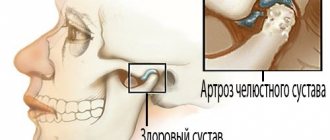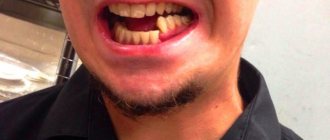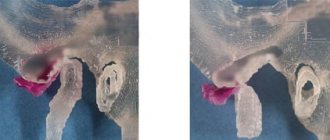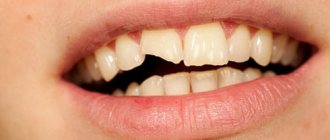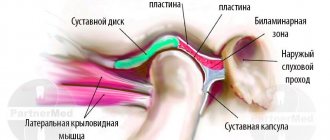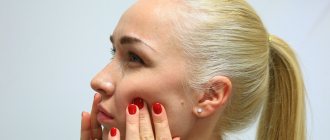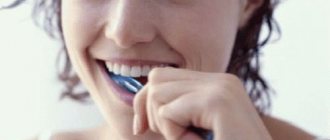What is temporomandibular joint dysfunction?
Dysfunction, essentially a dysfunction, is characterized by a change in the trajectory or limitation of the amplitude of movement of the lower jaw when the joint is not able to provide mobility adequate to the situation. For a long time, a person may not experience any unpleasant sensations in the joint area due to its dysfunction, however, after a visit to the dentist, excessive load on the dentofacial system when chewing hard food or a stressful situation, pain and other unpleasant symptoms may appear.
Varieties of mouth guards
In order to identify factors causing the development of abnormal processes, a comprehensive examination is carried out, including not only visual examination and palpation, but also hardware diagnostics. The list of additional techniques includes:
- Radiography;
- CT, MRI and electromyography;
- Study using a Doppler apparatus.
The results of the examination allow you to determine the type of mouthguard suitable for treatment. There are several varieties that differ in functional characteristics:
- Positioning correctors – designed to forcibly change the position of elements of the dentition, as well as align the occlusion;
- Relaxation mouth guards – relieve muscle tension and correct joint position, restoring neural balance;
- Decompression trainers - allow you to relieve the patient from uncontrolled tissue contractions, reduce the load during the closure of rows and prevent intensive abrasion of the enamel when diagnosing bruxism;
- Stabilizers - are used to return the mandibular region to its natural position, accompanied by movement of the condyle to the central line of the TMJ;
- Reducing trays, like positioners, are designed to change the position of row units and jaw arches, characterized by displacement or rotation.
Based on the specifics of the pathology, the installation of a mouthguard is carried out both on one row of teeth and on both jaws - depending on what kind of therapeutic effect is the final goal of treatment.
Features of operation and care
The patient is trained in the rules of using mouthguards when the finished kit is issued. Removable structures are easy to fix and remove, and allow temporary removal if necessary. To maintain the product in proper condition, it is recommended to follow simple rules:
- Rinse the mouthguard with running water twice a day;
- Clean daily using a soft brush;
- Avoid applying excessive pressure to the mouth guard;
- Store in a special case filled with solution;
- Refrain from smoking and consuming products with viscous and sticky consistency.
If you follow the recommendations, you can maintain the appearance and functionality of the product for the entire treatment period.
Causes of the syndrome
Let's take a closer look at the causes of TMJ dysfunction.
- Myogenic causes. Impaired functioning of the masticatory muscles certainly affects the condition of the joint, because a joint is an articulated joint, the position of the segments of which is determined by muscle tone. Excessive or asymmetrical tension in the muscles involved in chewing can lead to TMJ dysfunction.
- Odontogenic causes. Violation of tooth contact after installing a filling on the chewing surface of the tooth changes the position of the joints when the jaws close. Removing molars, “sevens” and “sixes,” deprives the joint of support when chewing. According to the figurative expression of orthodontists, the TMJ begins to “limp” when chewing food. A change in bite during orthodontic treatment, when the functional work of the jaws is sacrificed for aesthetics and perfectly straight teeth, can also injure the joints.
- Psychogenic reasons. A person is naturally endowed with a wide range of emotions, but he cannot always show them when in society. Therefore, in order to suppress rage or anger, you have to grit your teeth and endure, without showing others what is going on inside you. In the resting position, the distance between the teeth of the upper and lower jaw is several millimeters. Normally, we close our jaws when swallowing saliva or food, as well as when chewing. In a state of chronic stress, a person may constantly clench his teeth not only during the day, but also at night. Bruxism - teeth grinding during night sleep - is a frequent manifestation of psycho-emotional stress and one of the causes of TMJ dysfunction.
Case from practice
Ivanov Vadim Valerievich
Candidate of Medical Sciences, osteopath, neurologist, member of the expert council of the International Institute of Psychosomatic Health.
Ask a Question
Patient A., 39 years old, complained of pain in the masticatory muscles and the inability to open her mouth wide. The complaints appeared three days before contacting the osteopath after visiting the dentist. An osteopathic examination revealed malocclusion (distal occlusion with deep overlap of the dentition), tension and pain on palpation of the masticatory muscles, as well as in the area of the temporomandibular joints. Myofascial techniques were performed aimed at relaxing the masticatory muscles and ligaments of the temporomandibular joints. Immediately after the osteopathic session, the amplitude of mouth opening increased and the intensity of pain decreased. One session was enough to restore joint function. The patient was recommended to consult an orthodontist to resolve the issue of bite correction.
Kinds
There are several types of mouthguards that differ in their functionality. Let's look at each of them in more detail:
- Positioning. They place the teeth and jaw arches in the correct position in relation to each other.
- Relaxation. They help relax the chewing muscles, align the location of the joint and improve neuromuscular balance.
- Decompression. They relieve muscle hypertonicity during its uncontrolled contraction, normalize the occlusal load on the dentition, and prevent tooth abrasion. Most often prescribed for bruxism.
- Stabilizing. They return the lower jaw to the correct position, promote the movement of the condyle to the center of the temporomandibular joint, and create correct contact between the teeth.
- Replicating. Correct the position of the jaws and individual teeth (if they are displaced or rotated).
Wearing relaxation mouth guards is possible in combination with braces.
The mouth guard is installed on one jaw or on both jaws at once. In each specific clinical case, the doctor selects the option that will have the desired therapeutic effect.
How to diagnose TMJ dysfunction?
Diagnosing TMJ dysfunction is not difficult and can be done in a few minutes. Here are the main signs of joint dysfunction:
- Clicking sound when opening the mouth. There is a disc in the joint that provides variability of movement, “smoothing” angles and asymmetrical traction that occurs when the masticatory muscles contract. If a click occurs when opening the mouth, it means that the head of the lower jaw jumps off the disk and leaves the functional comfort zone, which under certain conditions can lead to a breakdown in adaptive resources and the development of inflammatory and degenerative changes.
- Limitation of mouth opening. Normally, a person should freely open his mouth to the width of 3 fingers of his non-dominant hand (for right-handed people this will be the left hand) as shown in the picture:
- Pain on palpation of the masticatory muscles. Available for superficial palpation are the temporal muscles and the masticatory muscles themselves. The pain occurs due to chronic spasm of these muscles. To palpate the temporal muscles, place the pads of the index and middle fingers of both hands in the temporal region and clench your teeth. When you squeeze your jaw, the muscle fibers will be contoured under your fingers. To palpate the chewing muscles themselves, the fingers must be placed in the area of the corners of the lower jaw and also squeeze the teeth to make sure that the muscles are tense under the fingers. If finger pressure provokes pain both during contraction and at rest, then the muscles are in increased tone.
- Pain in the TMJ area. To palpate the heads of the lower jaw, you need to place your fingers in front of the tragus of the auricle on the left and right, then open your mouth to feel the sliding of the lower jaw under your fingers and lightly press on the soft tissues:
We can talk about reliable TMJ dysfunction if there is a click and restriction of movement when opening the mouth, pain on palpation of the masticatory muscles and the joint itself.
The diagnosis can be confirmed by performing an MRI of the temporomandibular joint.
Diagnostic measures
When diagnosing TMD, clinical, radiographic and functional diagnostic methods are used. In recent years, endoscopic technologies have been given particular importance in diagnosing internal joint disorders.
In some cases, general clinical examinations (general and biochemical blood and urine tests) are useful.
Clinical methods include visual examination of the maxillofacial area and oral cavity , auscultation and palpation of the TMJ, assessment of its mobility (angulometry), palpation of the cervical and masticatory muscles. Before the examination, the patient is questioned about complaints and an anamnesis is collected.
X-ray studies include radiography in its main types (orthopantomogram, teleroentgenogram) and tomography (CT, MSCT, MRI). Unlike other methods of radiation diagnostics, MRI provides optimal visualization of joints , showing in detail all pathological changes in the ligamentous-capsular apparatus and articular disc.
Functional methods include muscle electromyography, axiography (registration of the trajectory of LF movement), audiography (hearing test) and other tests.
Phonoarthrography is used to listen to sounds occurring in joints.
Palpation of the muscles allows you to detect trigger points responsible for the occurrence of pain.
Dental status is assessed by the condition of the chewing teeth, deformation of the dentition, the presence of over-inflated fillings, deviation from the norm of the interalveolar distance and other parameters of the dentofacial apparatus.
If necessary , doctors of other specializations whose area of interest intersects with the functioning of the TMJ can be involved in the diagnosis - radiologists, orthodontists, orthopedists, otolaryngologists, neurologists.
Differential diagnosis separates TMJ dysfunction from inflammatory, infectious and traumatic arthropathies, as well as from neuralgia of the branches of the trigeminal nerve, arthritis of various etiologies, cervical osteochondrosis and other neurological diseases.
Symptoms of TMJ dysfunction
In 1934, the American otolaryngologist D. Kosten first described the symptoms that occur with TMJ dysfunction, and can also be manifestations of arthritis or arthrosis of this joint:
- restriction of mouth opening when talking and eating;
- the sound phenomenon of a click when opening the mouth;
- burning pain in the throat and root of the tongue;
- pain in the jaw, ear, eye, neck;
- slight asymmetry of the face due to uncoordinated work of the masticatory muscles and hypertrophy of muscle tissue on the side of excess load;
- noise in the ear/tinnitus and hearing loss;
- dizziness.
Classic Costen's syndrome is uncommon in clinical practice, but some of the symptoms of this syndrome can be misleading to doctors and patients. Often a person goes from an otolaryngologist to a neurologist, wanting to receive adequate help, he is given various examinations, given many diagnoses, and therapy is unreasonably prescribed, although the main problem that requires correction is TMJ dysfunction.
Duration of treatment
The duration of mouth guard therapy for TMJ dysfunction is determined individually and depends on the severity of the pathological process. Treatment may take several weeks or months. In rare cases, a year or more. It is necessary to visit the clinic periodically to monitor the progress of treatment and make adjustments to the condition of the surface of the structure. For example, you may need to add or remove excess material.
The first results will be noticeable within a few days. The signs of TMJ dysfunction begin to weaken and then completely disappear. The load on the ligaments is reduced and their functionality is restored. The teeth are aligned and the muscles are relaxed. With bruxism, the abrasion of enamel decreases. Overall, the condition of the oral cavity improves significantly.
Sometimes, a mouthguard is only part of a comprehensive treatment. In such cases, you can only wear it at night. If this is the main method of therapy, then you need to wear it at least 17-20 hours a day.
The achieved results are always consolidated with the help of orthodontic or restorative treatment.
According to patient reviews, after therapy with a joint cap, the symptoms of TMJ dysfunction decrease or completely disappear in 85% of cases. The device helps relax the jaw and puts the joint in its “right place.”
Treatment of the disease
Based on the causes of TMJ dysfunction, an individual treatment plan is planned. For muscle spasms, muscle relaxants are prescribed (mydocalm, sirdalud), non-steroidal anti-inflammatory drugs (diclofenac, movalis, ketorol, arcoxia, etc.) are used to relieve pain; in case of chronic pain, antidepressants (Cymbalta, amitriptyline) or anticonvulsants (gabapentin, finlepsin) are used. .
Physiotherapeutic procedures include transcutaneous stimulation of the nerves of the facial area, phonophoresis, laser therapy, and magnetic therapy.
The osteopath acts locally on the masticatory muscles and the dentofacial complex, and also performs global body balancing techniques, correcting associated somatic dysfunctions.
The patient is recommended to self-massage the masticatory muscles, perform exercises on the muscles of the face and neck, using the principle of post-isometric relaxation. A set of exercises is prescribed individually depending on the severity of the pain syndrome and the stage of the disease.
In case of pathology of the dental system, an orthodontist consultation is necessary to determine treatment tactics. It is possible to manufacture a mouthguard that releases the bite, which the patient uses during sleep to relax the masticatory muscles. This is especially true for patients with bruxism.
It may be necessary to correct the bite using braces or other corrective devices to eliminate TMJ dysfunction. If the patient has previously had molars removed (“sixes”, “sevens”), restoration of the integrity of the dentition is necessary to create support for the temporomandibular joint during chewing.
If TMJ dysfunction manifests itself against the background of a current psychotraumatic situation or chronic stress, a consultation with a psychotherapist is required for effective treatment. In general, dysfunction of the temporomandibular joint can be considered a classic example of a psychosomatic disease, since in most patients with this pathology, when interviewed, psychological problems are revealed, expressed by increased anxiety or subdepressive state. Often a person reacts to stress by unconsciously clenching his teeth without even noticing it. This is one of the reasons for the increased load on the TMJ.
If TMJ dysfunction is left untreated, arthritis (inflammation) of the joint may develop, which over the years can lead to arthrosis (degenerative changes and destruction of articular cartilage). To prevent this, timely assistance from specialists in various fields is necessary: osteopath, orthodontist, psychotherapist. Only an integrated approach to the treatment of this disease can guarantee success.
Wearing rules and care
The doctor shows the patient how to properly put on and take off the product. The design does not cause any particular discomfort when wearing and is convenient to use. It is invisible, easy to attach and hold. If necessary, it can be removed (for example, before a public event).
Care instructions:
- Rinse the product morning and evening under running water.
- Once a day, clean the device when removed with a brush and toothpaste.
- Do not squeeze the mouthguard between your teeth. There should always be a small gap between the lower and upper rows of teeth.
- Store in a humid place (in a closed container in a special solution). Thus, the material remains soft.
- Do not expose to high temperatures.
- Stop smoking (tobacco tar negatively affects the material).
- Do not use chewing gum.
If you follow all the above rules, you can maintain the appearance and functionality of the product for the entire period of treatment.
If wearing a mouthguard begins to cause severe pain, you need to remove it and consult a specialist.
Symptoms
The symptomatic picture of TMJ dysfunction is often quite pronounced, but most often it is quite difficult to accurately determine the presence of a problem in the joint, since some clinical manifestations are similar to other pathologies. For example, this disorder is often confused with subluxations of the TMJ, the symptoms of which are very similar, but treatment regimens differ radically.
Among the key manifestations of temporomandibular joint disorders are: • Clicking and various unpleasant sounds in the joint. The most common sign of damage to the temporomandibular joint is clicking in the lower jaw. They can be very loud, so much so that even those around them can hear them (for example, while chewing, yawning, or simply opening the mouth). The sounds can either be accompanied by pain or be completely painless, but in any case they indicate reposition of the articular disc. This misalignment causes excessive contraction of the muscles that are responsible for moving the jaws. This tension in the joint leads to pain in the cervical spine and pain in the facial muscles. • Headache. As a rule, in case of disorders, the localization of cephalgia most often occurs in the temples, occipital region, or even the shoulder-scapular girdle. Pain caused by slipped discs can radiate to the temples, forehead or cervical region. Headaches can be so severe and intense that they are mistaken for migraine manifestations or dangerous brain lesions, and an incorrect treatment strategy is prescribed. • Changes in bite. TMJ problems often manifest as dental malocclusion. • Ear symptoms. The close location to the shells of the ears leads to the fact that if the joint is affected, ear pain, ear congestion or muffled sounds (up to partial deafness) are possible. • Increased sensitivity of teeth. When the TMJ disc slips, the teeth become hypersensitive. This occurs due to jaw clenching and teeth grinding. Patients often turn to a dentist with this problem, who is not always able to detect the cause - the pathology of the temporomandibular joint. • Inflammatory processes. Symptoms are pain in the joint, swelling of the surrounding tissues and increased body temperature, combined with a general loss of strength and malaise. In addition, frequent manifestations of dysfunction of the temporomandibular joint include: • excessive tone of the muscles responsible for the movement of the lower jaw; • pain localized in the joint or chewing muscles; • slight swelling of the face and neck; • uneven movement of the joint when opening or closing the jaws; • problems with the cervical spine.
In this case, all of the listed manifestations, or only individual symptoms, can be observed. A significant part of the symptoms are similar to a dislocation, although the treatment is radically different. For this reason, it is extremely important to undergo a thorough diagnostic examination to make an accurate diagnosis and develop the correct treatment strategy.
